Keep Your Brain Sharp - Best Brain Training Tools for Anti-Aging
Discover the benefits of anti-aging brain training tools on our blog. Learn how neurofeedback can help optimize brain function as you age.
Learn about the best practices to train the brain in New York City that boost cognitive and emotional fitness, reduce stress, and promote healthy sleep habits.
The brain is a powerhouse of possibility. What we perceive, remember, and feel can be impacted by the smallest of actions and inputs. As a result, brain training comprises a kaleidoscope of activities, in fact, any activity that helps to optimize brain performance can be considered brain training. The best brain training tools address all areas of wellbeing and consider not only how to maintain functioning but to enhance it. This includes performance in areas under conscious control, such as problem solving and concentration, as well as unconscious functions, such as memory, stress response and sleep quality.
.png?width=519&name=best-brain-training-tools-illustration%20(3).png)
With today's advancements in understanding the brain and its functioning, brain training can have a larger impact than we ever imagined. Neuroscience research now confirms that the brain is plastic and is constantly changing. Neuroplasticity is the term we use to describe the brain's ability to create new brain cells and new connections between areas of the brain throughout life.
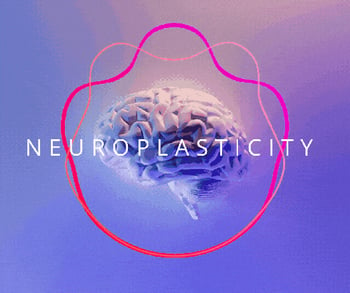
We are only recently discovering the brain's ability to change and improve functioning throughout the lifespan. In the early 1990s, the neuropsychological understanding of the brain was that it was a fixed system. In that view, injuries to the brain were permanent. For example, if a person suffered a stroke and had damage to the brain's language center, that damage was considered unrecoverable. Current research shines a light on the limitations of this view. We now know that rather than static and closed, the brain is an ever-changing, dynamic system geared for novelty and adaptation. Research shows that our brains retain neuroplasticity through adulthood--meaning we have the capacity for life-long improvement, growth, and even repair.
This breakthrough allows us to unlock the potential for healing and growth. The brain is able to re-wire itself to improve its functioning, and can even re-locate functioning to a new area when one region can no longer support it. Not only can the brain adopt new skills, it can physically adapt its structure to delegate existing tasks.
Choosing the right brain training program depends on your goals. The best brain training can be an app or device, but may also be something less tangible, like re-training how you talk to yourself or learning a new behavior. Some of the interventions are still too new to show conclusive benefits, but here are some of the most accessible brain training strategies and apps, and how they have been considered up to now.
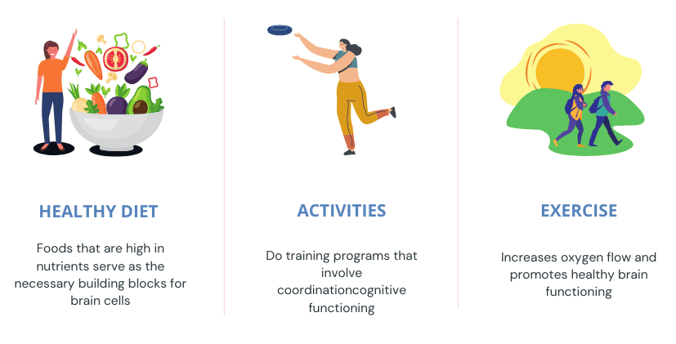
Exercise is an excellent form of brain training as increases oxygen flow and promotes healthy brain functioning. Regular exercise has been found to stimulate the release of growth factors -- chemicals in the brain that mediate the strength and the abundance of brain cells, as well as their plasticity and connections. In reducing inflammation and supporting metabolism, mood stabilizes and stress levels dissipate. Essentially, exercise helps the brain to create an environment for regulation and repair. This also leads to better sleep, an indispensable and powerful form of emotional first aid.
The brain's ability to remain flexible and resilient depends on the duration and intensity of exercise. Exercise can come in many different forms and choices (i.e. choosing to take the stairs over the elevator). Examples of exercise such as interval training have shown to improve cognitive functioning such as memory and attention. A new study shows that aerobic exercise can also improve executive functioning. Even a small dose of exercise -- as little as 15 minutes a day at moderate-intensity such as brisk walking, hiking, or cycling -- can have significant health benefits in comparison to remaining sedentary. Accumulating 150 minutes per week at this intensity of exercise is ideal to keep the brain in optimal shape.

Research shows that doing activities that are novel and work on practicing gross motor skill building -- such as juggling lessons or learning how to throw a frisbee -- can have a substantial impact on cognitive functioning. In a recent study at the University of Montreal, they separated elderly adults into three groups: two exercise groups and one "motor skills" group, which only performed light and novel activities, such as breathing exercises, walking through obstacle courses, juggling lessons, stretching, and throwing balls at targets.
The researchers intended for the motor skills group to be the "control" group (i.e. not improve during the research period); only the two exercise groups were meant to have potential improvements in cognitive functioning. Surprisingly, they found the "control" group improved as much as the actively exercising groups.
Other studies have found that training programs that involve coordination -- such as balance training, hula hoops, and obstacle courses--can have as big of an effect on the brain as more conventional exercise. Researchers assume it has to do with the level of cognitive engagement and novelty of the task, both of which foster novel connections between neurons.
Engaging in activities that work on motor skills but are also fun and playful can also have a positive impact on mood and can help to relieve stress.
Diet has well-researched effects on brain functioning. The food we eat impacts mental and emotional fitness. Following healthy dietary patterns has a positive impact on all aspects of wellness. See a list of foods that are robust brainpower boosters:

Knowing what to eat is just one side of the coin. Many studies have shown that diets high in sugar negatively impact brain functioning. One reason is because sugar interferes with the gut's ability to produce the neurotransmitter serotonin, a key player in stabilizing mood.
Other studies show that inflammatory foods induce "brain fog" -- difficulty focusing, remembering tasks and maintaining energy for problem solving and long-term concentration. These foods include meats (such as hot dogs, salami), sugary drinks (soda and high fructose fruit juices), white breads and various sweets.
Keep in mind that Foods that are high in nutrients serve as the necessary building blocks for brain cells. Knowing what to eat and what to cut back on can have substantial effects. Healthy dietary patterns are an essential form of brain training.
What are the best brain training tools available in 2021? A combination of interventions that support a healthy brain in different ways.
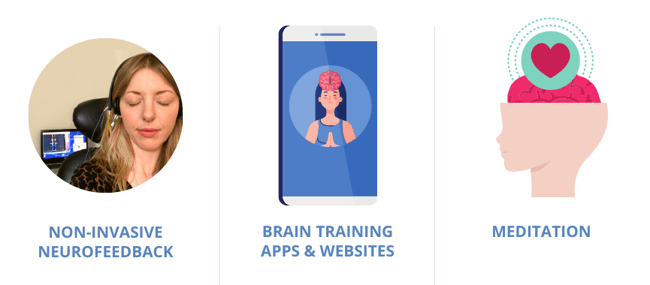
It is best to start with one change in a high impact category such as food or exercise. Three months of consistency turns a behavior into a positive habit. For example, you may decide that while you walk around New York a lot, you don't get high impact exercise. High intensity training (HIIT) has been effective even when done for 20 minutes. So you may add a HIIT workout online 3 days a week, or joining an outdoor class on the Hudson River.
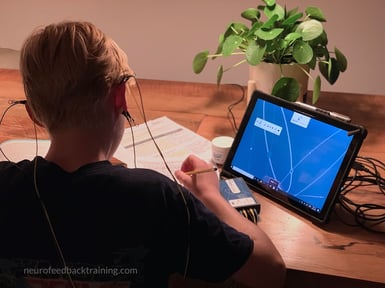 Neurofeedback devices are at the forefront of brain training technology. Using precisely timed feedback, they work to help recognize and reset ineffective patterns. These brain habits can be associated with poor focus and concentration, feeling overwhelmed, ineffective sleep, and worrying. Neurofeedback is a great brain training tool as its goal is to optimize overall mental and emotional performance.
Neurofeedback devices are at the forefront of brain training technology. Using precisely timed feedback, they work to help recognize and reset ineffective patterns. These brain habits can be associated with poor focus and concentration, feeling overwhelmed, ineffective sleep, and worrying. Neurofeedback is a great brain training tool as its goal is to optimize overall mental and emotional performance.
Neuroscience has come to understand that our mental and emotional habits are, in part, the result of the brain's electrical activity being stuck in repetitive cycles. What this means is that when a person forms a hard-to-break habit, such as struggling to concentrate on tasks or repeating unhealthy routines, this is reflected in the individual's brainwave activity.
Neurofeedback software tracks brain wave activity collected through EEG sensors attached to the head. When the software picks up on an electrical dance indicating a change in brain patterns, it alerts the brain (through auditory or visual feedback) to pay attention. This microsecond by microsecond feedback allows the brain to orient itself to the present moment, recognize patterns and reset maladaptive ones.
There are a lot of devices that call themselves neurofeedback. It is important to stay up-to-date on the best neurofeedback equipment. Neurofeedback has a range of benefits, including optimizing attention, memory, emotional regulation, and sleep management.
.png?width=368&name=brain-training-activities-for-brain-health%20(3).png)
Brain training apps are known to train cognitive fitness. These apps can be quickly downloaded from the app store on your smart phone or on specific websites. They work by offering mini-games designed to improve performance of various cognitive skills, such as concentration, memory and mental agility. By keeping scores, the user can track their progress over time.
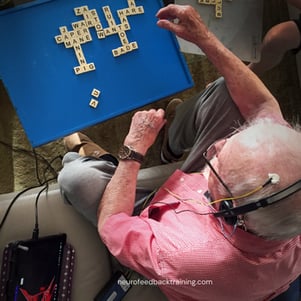 One study showed that a brain training app used by elderly participants slowed their cognitive decline. Some of the most popular apps are Elevate, Peak, and Luminosity. Luminosity is one of the most popular websites that exercises a myriad of skills from math to word games, all designed to boost cognitive abilities. The app Elevate is designed to train specific goals: to improve the user's concentration, writing skills and productivity.
One study showed that a brain training app used by elderly participants slowed their cognitive decline. Some of the most popular apps are Elevate, Peak, and Luminosity. Luminosity is one of the most popular websites that exercises a myriad of skills from math to word games, all designed to boost cognitive abilities. The app Elevate is designed to train specific goals: to improve the user's concentration, writing skills and productivity.
The drawback to using brain training apps for mental fitness is that they often lack the social element. Consider playing games with others to reap the emotional benefits of social connection. It's been shown that people who play board games regularly, such as card games and chess, have lower depression levels and reduced cognitive decline.
 Engaging in a regular meditation practice has many health benefits. It has been shown to reduce stress and increase focus. Additionally, meditation creates calm, lowers blood pressure, and cultivates greater mental focus and concentration. There are a multitude of different meditation practices. For example, meditation based on practicing compassion and gratitude can increase emotional wellbeing. Body-scan meditation practices are helpful for reducing stress. It has been found that people rely less on pain medication when they practice Mindfulness Based Stress Reduction (MBSR) for pain management.
Engaging in a regular meditation practice has many health benefits. It has been shown to reduce stress and increase focus. Additionally, meditation creates calm, lowers blood pressure, and cultivates greater mental focus and concentration. There are a multitude of different meditation practices. For example, meditation based on practicing compassion and gratitude can increase emotional wellbeing. Body-scan meditation practices are helpful for reducing stress. It has been found that people rely less on pain medication when they practice Mindfulness Based Stress Reduction (MBSR) for pain management.
When looking at the structure of the brain, meditation has tangible effects on areas involved in emotional regulation. After meditation training, the amygdala, a key player in the anxiety/fear response, shows decreased activity and more connectivity with the prefrontal cortex. This is important for impulse control and emotional regulation. This finding indicates that mindfulness can positively impact anxiety as measured by changes in its neural connections and activity.
The best brain training in NYC is not a single strategy, but a combination of the tools listed above. The more frequent and consistent you are with training, the better the results will be. Think about your goals and how training can work best for you. Get ready to grow, innovate and inspire!
Natalie Baker has over 25 years of experience as a licensed psychotherapist and has been a NeurOptimal® neurofeedback trainer since 2011. She is the founder of Neurofeedback Training Co., which offers in-person sessions and runs the largest nationwide home rental program for NeurOptimal systems. Natalie also teaches meditation and Buddhist psychology and specializes in working with anxiety, stress, ADHD, and trauma.
Discover the benefits of anti-aging brain training tools on our blog. Learn how neurofeedback can help optimize brain function as you age.
Improve your cognitive abilities with the best brain training tools. Visit our blog to discover the latest research and techniques.
Discover the science behind brain training and unlock the potential of your mind from the comfort of your own home with affordable brain training...
Be the first to know about new blogs